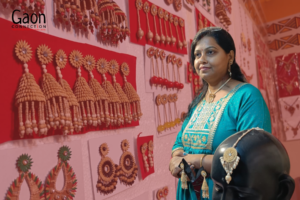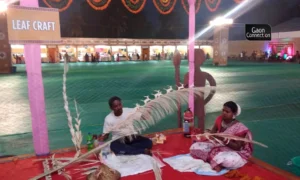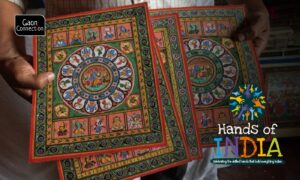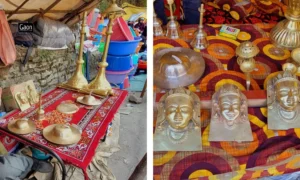Jamshedpur, Jharkhand
There is a painting of a woman astride a horse and she is holding aloft a sword. It is made by Sumanti Devi Bhagat, an artist, who belongs to the Oraon tribe.
“The lady represents the courage of three tribal women from Rohtasgarh — Singi Dai, Kaili Dai, and Champa Dai — who protected the Oraon villagers from enemy attack thrice,” Sumanti Devi from Shylla village in Jashpur district, Chhattisgarh, told Gaon Connection.
“The painting also commemorates the Janishikar festival that is celebrated once every 12 years in honour of these women. Women from the Oraon tribe go on animal hunts on this occasion,” the artist added who has recently travelled to Jamshedpur in Jharkhand to attend Samvaad, a tribal conclave organised by Tata Steel Foundation.
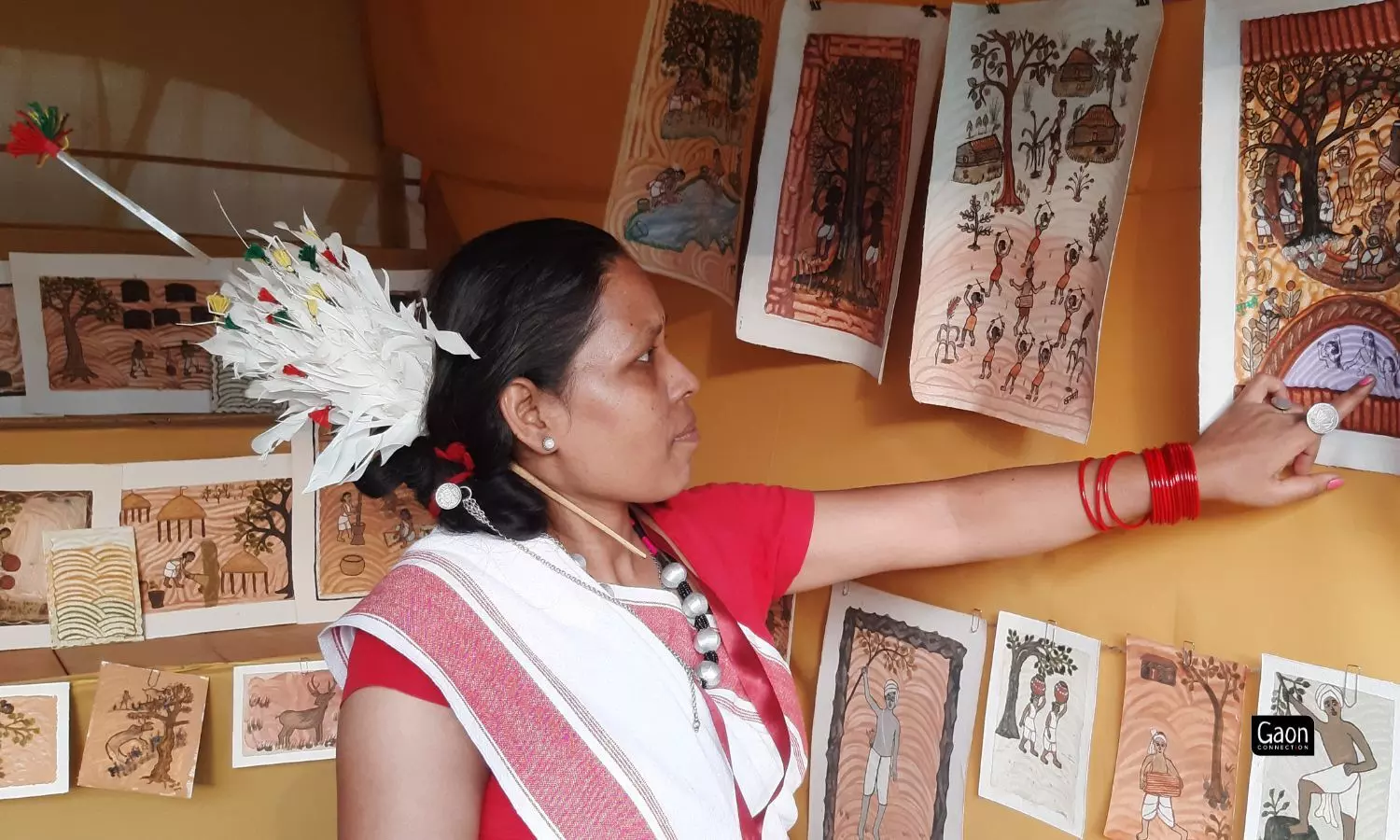
A big part of the colours in an Oraon painting come out of soil of different colours. Tribal artists dilute the red, brown and red soil in water and use that as paint.
Like tribal communities elsewhere, the Oraon tribe has its wealth of traditions and stories. The central India is famous for tribal paintings by Gond and Bhil communities. But there are also lesser known Oraon paintings that are made purely using natural materials like mud and soil. Each painting narrates a story related to the Oraon tribe’s history and culture.
“Whereas other tribal artists have started to use acrylic and other chemical paints, we still use only natural colours derived from Earth,” said Sumanti Devi who sat surrounded by her paintings in Gopal Maidan of Jamshedpur. She is a post graduate in Political Science.
Also Read: For the Love of Art and Nanpur Village
A big part of the colours in an Oraon painting come out of soil of different colours. Tribal artists dilute the red, brown and red soil in water and use that as paint. “As children we painted on the walls of our homes, but about 15 years ago, we decided to do the same paintings on paper and canvas to spread more awareness about it,” the artist added.
“We get the colour red sometimes by burning straw, and for white we use rice powder. Black comes from crushed charcoal. We have always made the colours at home. We never use shop bought or chemical based colours,” she reiterated.
Sumanti Devi and her sister Anamika still go into the forests and fields to find the raw materials for their colours.
Painting Gotras on the Walls
Tribal communities in Chhattisgarh, Jharkhand, Bihar, West Bengal and Odisha paint on the walls of their homes. There are birds, animals, trees and people depicted on the walls and each depiction has a story behind it.
The Oraon community paints the walls of their homes once every year. What they paint represents their gotra or sub caste.
“There are 12 gotras that are represented by different creatures. For example the tiger is for the Lakra gotra, the tirkhai bird for the Tirkey gotra, fish for the Minj gotra, and tortoise for the Kachhap gotra,” Sumanti Devi explained.
“The paintings we do speak of our evolution, the struggles our people faced and how we survived them since primitive times. And, these paintings that are also old, are all made from natural colours, sourced from the soil, plants and roots around us,” she added.

Tribal communities in Chhattisgarh, Jharkhand, Bihar, West Bengal and Odisha paint on the walls of their homes.
In one of the paintings that hangs behind Sumanti Devi at her stall in Gopal Maidan, there is a tree under which villagers are sheltering. “They sought the protection of the tree and their enemies could not find them, and they were saved. The Oraon people celebrated the tree in a festival called Karam to honour it,” she said.
There are some rules to the paintings too. Paintings done on their altars are only to be done by men. This is called ‘Dandpatta’. This is usually made at the site of worship to mark auspicious ceremonies.
From Mud Walls to Paper and Canvas
Sumanti Devi said that she wanted to preserve her tribal art and make people aware about Oraon history and culture through painting and it was not possible to do that if it was confined to the walls of their homes. So she started painting on paper and canvases.
“We teach this art to interested children, whenever we get a chance during culture based seminars or exhibitions like this organised by Tata Steel Foundation in Jamshedpur. We have exhibited our work here for 10 years thanks to Samvaad,” Anamika Bhagat, Sumanti Devi’s sister, told Gaon Connection. She hoped the state government would also provide the artists more platforms to showcase and further their art.
“An artist takes about three to four days to make a painting. The colours are used in layers and therefore we have to wait for one layer to dry before we apply another. Depending on the size, the complexity of the painting and the colours used, the paintings sell anything from Rs 150 to Rs 2,000 each,” said Anamkia.
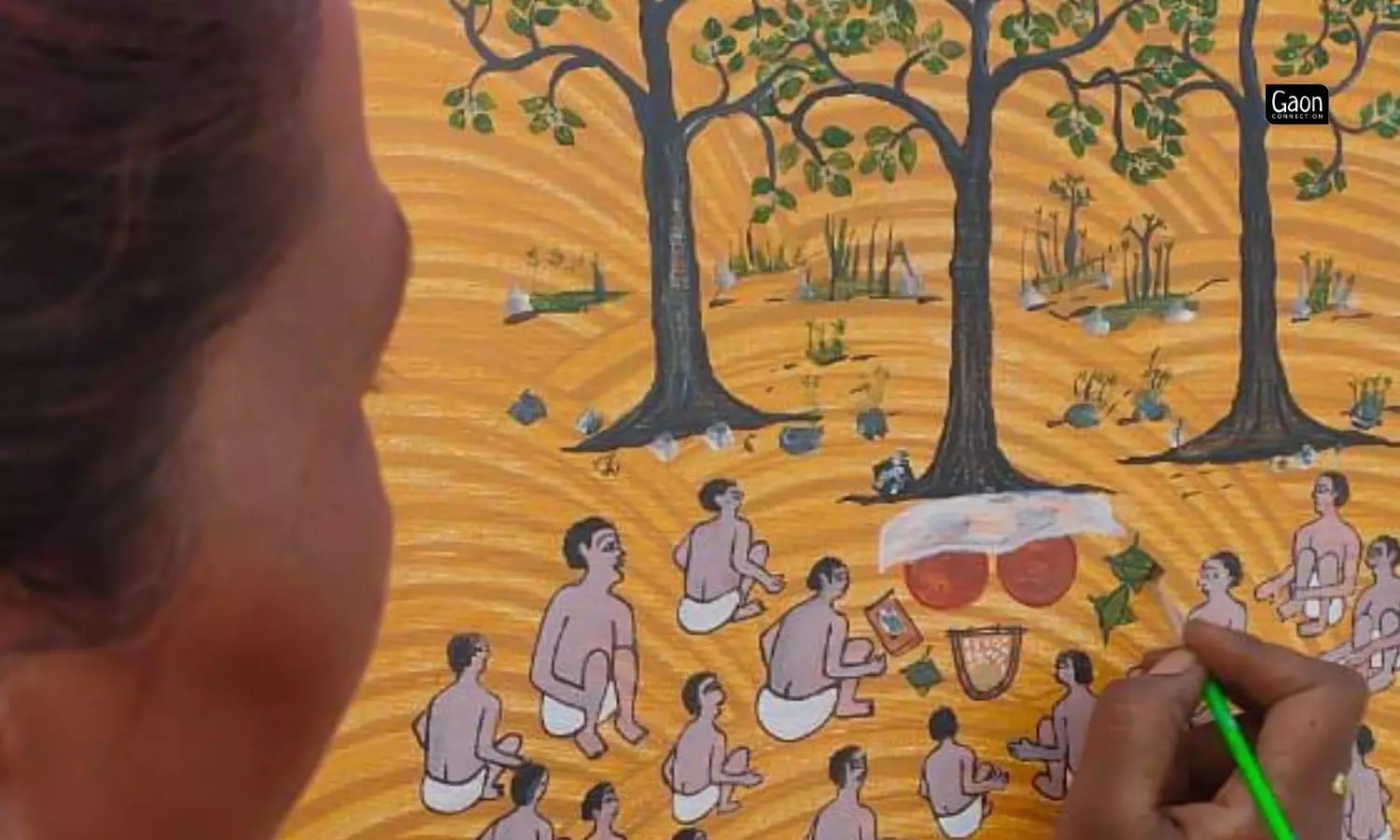
The painting also commemorates the Janishikar festival that is celebrated once every 12 years in honour of these women.
Also Read: Colours of Communal Harmony in West Bengal’s Pattachitra Art
The Oraon sisters attend art fairs whenever they can. There was a setback during the pandemic, but they did not give up painting.
In 2018, Sumanti Devi received a fellowship from Tata Steel Foundation as part of which she put together a book on Oraon paintings, and also made a video documentary on the same.
It is difficult to persevere with painting as it is hard work and the returns are not good enough, the sisters said. But the artist sisters do not want to give up what they are doing as transferring the Oraon stories, art and culture onto paper and canvas is the only way they will stay alive, they said.







